
Qūraq qūrau – patchwork technique
The basic set of quraq composition is based on a set of geometric elements: triangle, square, rhombus, rectangle, etc., and the combination of these elements created meaning, a coded code. On the one hand, these are the most popular motifs in traditional art, and on the other hand their elements can easily create any geometric pattern. They have parallels in a number of Central Asian ethnic cultures.
Technically, the basis for patchwork patterns is a basic module – a square or rectangle. It can consist of different sizes of small pieces of fabric: squares, rectangles, triangles, etc. The simplest combinations of patchwork, with varying colour of fabric, result in many variations of ornaments, which in traditional culture have their own names and express different meanings.
The motif of a triangle with its top upwards (usually “tau” – mountain) or their succession, called tüye örkesh (camel’s hump) according to the Kazakhs symbolizes prosperity, addition to the family and the herd. As it is known, the mountain in Turkic mythology is a symbol of the spiritual Path, the ascent of the spirit, while the chain of such figures can also mean protection. The figure itself is a divine sign, a personification of upward aspiration, and a symbol of life. The meaning is close to the World Mountain, which unites all three worlds – heavenly, earthly and underground.
Another element often found in quraq is the sharshy (square), which is found in various combinations in patchwork techniques. The most popular is a small square placed in the centre of a contrasting large square in Tajiks called chashmaki gov (cow/bull’s eye), and in Kyrgyz and Kazakhs called bota köz (camel’s eye). According to experts, it is one of the oldest and most common elements of the patchwork ornament – both territorially and by its use in a wide variety of things. It is especially common on children’s things, cushions, quilts, wedding curtains. Another variation of the bot köz patchwork ornament is the rhombus within a square. From here it is interpreted as a magical pattern representing fertility, child-bearing functions and protection.
In large things it is combined with various figures. In general, sharshy in Turkic culture is a symbol of stability, which is associated with the four cardinal points, corresponds to the earth element and is a sign of the material world. The construction of an ornamental motif out of a chain of squares of contrasting colours is, in our opinion, a visual metaphor of life or an artistic device allowing to express the doubled or even tripled power of this or that sign/symbol.
A combination of a square and triangles forming a star-shaped figure is called zhūldyz by the Kazakhs. Another most popular motif of patchwork is the rhombus. In the connection of the two triangles by a base, some researchers see the union of opposites – male and female, heavenly and earthly, symbolising the union of the two worlds, the beginning of a new life. A rug with a rhombic ornament is considered a symbol of the Turkic goddess Umai.
The Kazakh quraq often uses the ush köz (three eyes) motif. The motif of three rhombuses is a classic technique in the arts and crafts of many Eurasian peoples, symbolizing the tree of life. In general, the rhythmic repetition of the same element can be seen as a way of reinforcing the main idea, demonstrating the particular strength of the composition. The chain of four diamonds Kazakhs call tört tüligi sai, in our view, metaphorically reflects the expression tört tülik – mal.
This is a popular understanding of the sanctity of four types of livestock: camels, horses, cows and sheep-goats. They were the main source of livelihood and served as peculiar animal markers of the sacral world, because according to the Kazakh people: eshki – saytannañ (goat comes from the devil); qoi – ottan (ram comes from fire); tüye – sordan (camel comes from earth); zhylqy – zhelden (horse comes from wind); siyr – sudan (cow comes from water). In this form, nomads represented the four natural elements: fire, air, earth and water, and this motif was often used in the decoration of cushion covers in quraq.
On the whole, the ornamental composition of the quraq and its refinement depended on the level of skill, but all of its technical nuances preserved the understanding of the patchwork as a reflection of the universe, as a family amulet and its presence in the dowry is perceived as a kind of talisman for the newly created family.
Obviously, in traditional culture the works of art, and the quraq as such, were closely connected with magic and ritual (wedding, funeral, the practice of veneration of sacred places, etc.), and many times the same visual metaphors reflect the stable formulas of description of certain subjects and notions about the World, which had a great pragmatic value.
The composition of the patchwork has a direct relation to its purpose. For floor quilts – körpe it is a closed composition, which is enclosed in a border – qorshau. In this case, the ornament could be both large-scale, consisting of large blocks, and small, composed of thin strips called shi quraq. It is the latter type is considered the pinnacle of craftsmanship.
More complex compositions consisted of a rectangular field divided into squares, each of which was filled with different patterns. For smaller items, such as quraq tösenish for chairs, sharashy compositions were used.
Rectangular compositions were of several types:
– mesh, where the pattern evenly fills the background of the field,
– medallion – with large figures along the field or one medallion (a central
principle of construction, which is more typical for square-shaped pieces),
– three-part with three large medallions along the entire field.
Today, this type of traditional art in Kazakhstan is experiencing a boom. The country has a strong Patchwork Association, which brings together a huge number of seamstresses, and is headed by Dana Ashimova. Artisans offer a huge range of products made in the technique of quraq, and besides, whole schools of patchwork are opened. This is primarily the activity of Gulmira Ualihan, a well-known craftswoman. She opened a social studio on quraq. As she says, quraq is a sacred handicraft, which absorbs energy and brings only positive things to people – warmth, good luck and happiness.
According to her, each quraq ornament has a deep meaning. For instance, the qustumsyq pattern symbolises the bond between a mother and her married daughter. The coverlet for the newborn boy encrypts the theme of valour and strength. In products for the newlyweds necessarily apply ornaments denoting the feminine, for the fertility of the young family.
Bota Nurabaeva from Taldykorgan is a well-known craftswoman who turned her hobby into a small business and started producing quraq körpe of various shapes and sizes. The craftswoman believes that the quraq körpe were an element of a Kazakh bride’s dowry in the olden days, and their meaning lay in well-wishes: Qūdai qurastyrsyn. It meant that the newlyweds were inseparable, close, always together, like these pieces of this blanket.
Nazgul Batyrkhan, a craftswoman from Sarkan, is also actively engaged in patchwork. She participated in the interregional forum of business women “Women’s Initiatives in the Sustainable Development of the Region”, where she won the Quraq körpe competition organised as part of the forum. A huge contribution to the development of traditional Kazakh patchwork in the Atyrau region is made by Kalampyr Kulmuratova, a well-known craftswoman of the region. Artisan regularly holds master classes and passes her knowledge to the young. One of the continuators of the ancient tradition of patchwork is Otar village resident Ulzhan Dosalieva.
Zhuldyz Ualieva from Ust-Kamenogorsk is among the well-known eamstresses and her works made in the quraq technique are always in demand. Thanks to such craftswomen, the Kazakh traditional technique of quraq is actively developing and continues to delight people.



